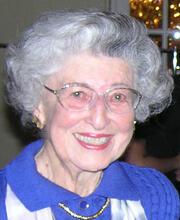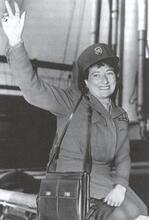Esther Schiff Goldfrank
Esther Schiff Goldfrank contributed greatly to the anthropology field through her studies of communities as disparate as Pueblo Indians and New Yorkers. After earning an economics degree from Barnard College in 1918, Goldfrank traveled to the Southwest with Franz Boas in 1921, studying Pueblo women and their recipes. After leaving to raise her family in White Plains, NY, in 1922, she returned to anthropological work in 1935, studying the tensions between older, secularized Jews and nouveau riche families at her daughter’s school, Fieldston, in the Bronx. She then returned to studying the Pueblo, and notably, after doing fieldwork with Ruth Benedict in 1939, challenged Benedict’s theories on the Pueblo personality. In 1948, Goldfrank became president of the American Ethnological Society, and spent four years and editing its monograph series.
Although she never received a degree in anthropology, Esther Schiff Goldfrank made significant contributions to Pueblo studies.
Family and Education
Born in New York City on May 5, 1896, Esther Schiff was the daughter of middle-class parents, Matilda (Metzger) and Dr. Herman J. Schiff. Her parents and her only sibling, Jack, died before she was twenty. She attended the School for Ethical Culture and graduated from Barnard College in 1918 with an A.B. in economics. Accompanied by Franz Boas and the anthropologist Elsie Clews Parsons, who financed her salary and trips to the Southwest, Esther began her fieldwork collecting recipes from a Laguna Pueblo woman in June 1920. In 1921 and 1922, she accompanied Boas to Cochiti Pueblo, where she wrote that, again, her “helpers were a group of women—by and large it was a woman’s party.” She wrote “The Social and Ceremonial Organization of Cochiti” (1927) based on her collaborative efforts with Carolyn Quintana, mother of now-famous potter Helen Cordero.
Work with Franz Boas
Goldfrank coined the name “Papa Franz” for Boas on the trip to Laguna in 1920, and the term gradually caught on among insiders, both men and women, in the anthropology department. Margaret Mead wrote that Goldfrank and Ruth Bunzel shared a “German Jewish ethos” with Boas that did much to transform the austere, intimidating “Herr Professor” into “Papa Franz” for all of his students. But in her autobiographical Notes on an Undirected Life: As One Anthropologist Tells It, Goldfrank remarks that although she was the first to use the name “Papa Franz,” it had nothing to do with a shared “German Jewish ethos” but with an experience in Laguna when Boas shed his employer role to become a “father-protector.”
Esther interrupted her career as an anthropologist in 1922 to marry Walter S. Goldfrank, a widower with three sons. She moved to White Plains, had a daughter in May 1924, and did not resume taking courses at Columbia until thirteen years later, after the sudden death of her husband in 1935.
Studying New York Jews
On her return to anthropology, she first studied New York City adolescents for the General Education Board of the Rockefeller Foundation. This work included an unpublished study of the influence of the Ethical Culture Society on the predominantly Jewish Fieldston School in Riverdale, New York, which her daughter attended. The study looked at how the population of Fieldston was divided between two groups: older Jewish “bluestocking,” socialist-minded, secularized adherents of Felix Adler’s philosophy of Ethical Culture, and “newer” nouveau riche families who observed Jewish holidays. The study also emphasized (“before black identity was part of our social vocabulary”) that black students who had begun to attend Fieldston should keep a foothold in the black community in order to maintain their identity and forestall racial traumas.
After this research, Goldfrank participated in Abram Kardiner’s and Ralph Linton’s culture-and-personality seminars at Columbia. In 1939, she went to study the Blood Indians in Alberta with a group of Columbia students under Ruth Benedict’s direction. She later used her Pueblo research and study of Blood kinship to challenge Ruth Benedict’s views on the Pueblo personality.
Opposing Ruth Benedict
Influenced by the research of her second husband, world-renowned historian and sinologist Karl Wittfogel, whom she married in 1940, she wrote several essays on the importance of irrigation for Pueblo organization and ceremonial life. These essays opposed Benedict’s Apollonian image of Pueblo society. Benedict, inspired by Nietzsche, developed her Apollonian and Dionysian classification of cultures and labeled the Pueblos as Apollonian in contrast to the rest of aboriginal America. From her “realist” perspective, Goldfrank questioned the validity of the configurational approach and emphasized disharmony in Pueblo society. She argued that Wittfogel’s ideas on waterwork societies were equally relevant for an understanding of the miniature water-deficient societies of the Pueblos as for the great nation-states of China, Egypt, and Peru. Goldfrank stressed the importance of irrigation for social and political organization, gender relations, and ceremonial patterns.
Wittfogel was ostracized by the intellectual community after he appeared before the Senate Internal Security Subcommittee in the 1950s and named some of his former students and colleagues as members of the Communist Party. Goldfrank’s role in this matter has not been established.
Goldfrank participated in the Columbia University Chinese History Project, which Wittfogel directed in the 1940s. She also completed and published Elsie Clews Parsons’s work on Iseleta paintings in The Artist of ‘Iseleta Paintings’ in Pueblo Society, published in 1967. She became president of the American Ethnological Society in 1948 and was editor of its monograph series from 1952 to 1956.
Esther Schiff Goldfrank never taught and, altogether, spent only six months in the field. Her career was limited by her vision of her role as a mother and wife, and the real demands of running a large suburban household. But despite these constraints, she influenced anthropological study by opposing culture-and-personality theory and focusing attention on the contingent nature of history and politics.
Esther Schiff Goldfrank died on April 23, 1997, in Mamaroneck, New York, at age 100.
Selected Works
“Another View: Margaret and Me.” In Ethnohistory, 30:1–14. Durham, NC: Duke University Press, 1983.
“Artist of ‘Isleta Paintings’ in Pueblo Society.” Smithsonian Contributions to Anthropology, no. 5, Washington D.C.: Smithsonian Press, 1967, 1–227.
Changing Configurations in the Social Organization of a Blackfoot Tribe During the Reserve Period. American Ethnological Society, Monograph 8. New York: J. J. Augustin, 1945.
“The Different Patterns of Blackfoot and Pueblo Adaptation to White Authority.” Top of FormSol Tax, and Melville J. Herskovits. Acculturation in the Americas: proceedings and selected papers of the XXIXth International Congress of Americanists. Chicago, Illinois: The University of Chicago Press, 1952.
“Historic Change and Social Character: A Study of the Teton Dakota.” American Anthropologist 45, no. 1, January 3, 1943: 67–83.
“The Impact of Situation and Personality on Four Hopi Emergence Myths.” Southwestern Journal of Anthropology 4, no. 3, October 1948: 241–62.
“Irrigation Agriculture and Navaho Community Leadership: Case Material on Environment and Culture.” American Anthropologist 47, no. 2, 1945: 262–277;
Editor. Iseleta Paintings, with introduction and commentary written by Elsie Clews Parsons, Rev. ed. Washington: Smithsonian Institution, 1970.
“More on Irrigation Agriculture and Navaho Community Leadership.” American Anthropologist 48, no. 3, 1946: 473–76.
Notes on an Undirected Life: As One Anthropologist Tells It. Queens College Press, 1978.
“Observations on Sexuality Among the Blood Indians of Alberta, Canada.” In Psychoanalysis and the Social Sciences, Vol. 3, edited by Geza Roheim, International Universities Press, 1951.
“The Social and Ceremonial Organization of Cochiti.” American Anthropological Association, Memoir 33, 1927.
“Socialization, Personality, and the Structure of Pueblo Society.” American Anthropologist 47, no. 4, 1945: 516–537.
Wittfogel, Karl A. “Some Aspects of Pueblo Mythology and Society.” The Journal of American Folklore 56, no. 219, 1943: 17–30.
“Two Anthropologists, the Same Informant: Some Differences in Their Recorded Data.” Journal of the Anthropological Society of Oxford 16, no. 1, May 1945: 42–52.
Babcock, Barbara A., and Nancy J. Parezo. “Esther Goldfrank, 1896–.” In Daughters of the Desert: Women Anthropologists and the Native American Southwest, 1880–1980. An Illustrated Catalogue (1988).
Caffrey, Margaret M. Ruth Benedict: Stranger in this Land (1989).
Goldfrank, Esther. Taped interviews. Wenner-Gren Foundation, NYC.
Herskovits, Melville J., ed., and Barbara Ames. “Goldfrank, Esther S.” International Directory of Anthropologists. 3d ed. (1950).
Lange, Charles H. “The Contributions of Esther S. Goldfrank.” In Hidden Scholars: Women Anthropologists and the Native American Southwest, edited by Nancy J. Parezo (1993).
Levitas, Gloria. “Esther Schiff Goldfrank.” In Women Anthropologists: A Biographical Dictionary, edited by Ute Gacs et al. (1988).
Mead, Margaret. An Anthropologist At Work: Writings of Ruth Benedict (1959).
Narvaez, Alfonso A. “Karl A. Wittfogel, Social Scientist Who Turned on Communists, 91.” NYTimes, May 26, 1988, B14.
Obituary. NYTimes, May 25, 1997, p. 38.
Theoharis, Athan G. “Authors, Publishers, and the McCarthy Era: A Hidden History.
Senator Joseph McCarthy.” USA Today 122, no. 2580 (September 1993): 90.
Woodbury, Nathalie F.S. “Goldfrank, Esther Schiff.” In International Dictionary of Anthropologists, edited by Christopher Winters (1991).
WWIAJ (1938).











